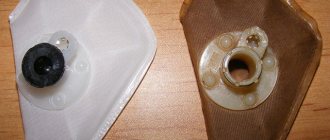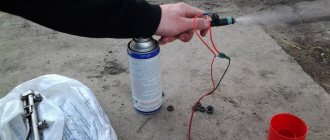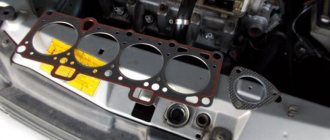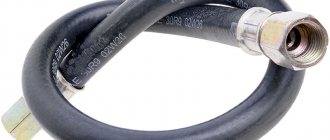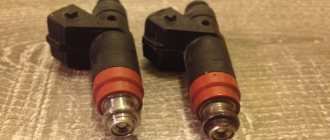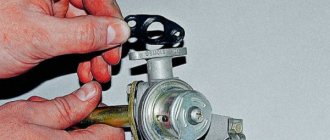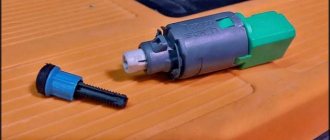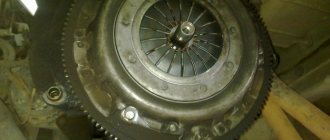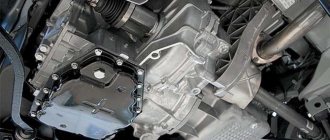Fuel supply system design
The fuel supply system of the Lada Vesta car consists of 5 parts:
- Gas tank with filling pipe. The gasoline tank is made of compressed plastic and is attached to the bottom of the car with two metal clamps. The filler neck is located on the right side of the Vesta. The plug has 2 valve mechanisms. One ensures the release of excess pressure created in the tank due to thermal expansion. The other serves to intake air, which fills the container when the liquid level in the gas tank decreases.
- Fuel module. Provides pumping of gasoline into the fuel rail. Consists of a fuel pump, bypass valve, gasoline level sensor and filter device.
- Injectors. Located on the ramp. Fuel is injected into the internal combustion chamber.
- Adsorber. The main component of the vapor recovery system. Located on the right side of the car, near the front fender. Equipped with a purge valve.
- Pipelines. Serve to transport fuel and gases between components of the fuel supply system.
Where is the fuel filter on the Vesta? Photo source: https://www.drive2.ru/l/527598181760894565
Unlike the design of the unit installed on previous AvtoVAZ models, the Vesta fuel filter is not portable. According to the manufacturer, the cleaner's lifespan is sufficient for the entire life of the vehicle. Sometimes cases of low-quality gasoline are poured in, which forces owners to replace the mesh in the Vesta filter.
Analogues of the Lada Vesta filter
If the entire unit needs to be replaced, then the Lada Vesta owner has no chance to save money. However, individual elements of the system can be replaced with cheaper analogues. For example, you can install a gasoline pump from the Japanese company AISIN, which will cost about 3,000 rubles. Installation of an electric fuel pump from a Kia Rio car, the price for which is 4,000 rubles.
Important: the analogues will have to be slightly modified in order for them to fit the Lada Vesta.
How much such work is worth at a reduced price - the car owner must judge for himself. It is believed that while there are no official analogues, it is better to replace the fuel module in a trusted service center and with an original one. Perhaps in the future this procedure will be simplified, or the part itself will become cheaper.
Article number and cost of the original fuel filter
The original Vesta filter element does not have an article number. On the open market, a mesh that performs rough cleaning can be found at a price of 165 rubles. Produces consumables. Under its logo you can find repair kits for the Lada Vesta fuel pump costing 950 rubles. The kit includes coarse and fine filtration devices, a pulsator tube and a lid (assembled).
Replacing the fuel filter. Photo source: https://www.drive2.ru/l/527598181760894565
In an official car service, they do not change individual components, but install a new unit. The catalog number of the fuel pump is 21800113900900. The cost of a new original unit averages 6,000 rubles.
Where is the fuel filter in Lada Vesta
The filter element, electric pump, like all other parts of the fuel module in the car are located behind the rear seat of the car, so in order to replace one of the parts of the module or the entire unit, car enthusiasts have to remove the rear seat cushions and soundproofing pads. The closest thing, namely right behind the pump inlet, is a coarse filter - a mesh - this is the only part of the entire unit that you can change yourself.
Manufacturers of Lada Vesta do not recommend replacing module components on your own, however, car enthusiasts have still found a way to disassemble and change filters without outside help.
When to change the fuel filter on Vesta
According to the manufacturer, the service life of the fine gasket is equal to the service life of the fuel pump. The fuel pump has a resource of 180 thousand kilometers. Photos on the Internet show dirty filter elements with more modest mileage figures.
On forums, car owners say that they change the fuel filter on their Vesta every 30-40 thousand km. The frequency of replacement is directly affected by the purity of the fuel used. When refueling at a suspicious gas station, the filter elements may become clogged within the first kilometers of driving.
Signs that replacement is needed
You can understand that the filtration device is clogged by some characteristic features of the machine’s behavior. These include:
- fuel pump noise;
- increased fuel consumption;
- reduction in engine power;
- car jerks when driving;
- floating idle speed;
- Difficulty starting the engine.
When the “Check Engine” light comes on and subsequent computer diagnostics, a clogged fuel filter displays error P0171.
Photo of the fuel filter on the Vesta. Photo source: https://www.drive2.ru/l/527598181760894565
These signs may also indicate other problems. But if the filter device was changed a long time ago, then you can start eliminating the problems by replacing it.
Factory filter Lada Vesta
A distinctive feature of the car is the combination of 2 cleaning parts in the fuel module: coarse and fine. Coarse cleaning is a mesh that can be changed. Fine cleaning is a paper filter element built into the module - accordingly, it can only be replaced with a fuel pump. Instead of separate filters, this model has a fuel module. Previously, cars were equipped with 1 small and cheap fine filter element, which stood at the bottom near the gas tank. The mesh was located under the seat in the fuel block. On Vesta, the part combines coarse and fine fuel filters and an electric fuel pump. Therefore, replacing one individual broken element is difficult. Typically, specialists replace the entire assembly, which significantly increases the cost of the operation.
When ordering a new fuel module, use part number 21800113900900 or 8450008680. In this case, you will receive a factory-made fuel assembly. Its price starts from 3500 rubles. At the same time, different stores may call the part differently: fuel unit, electric fuel pump module, electric fuel pump, electric fuel pump.
Part characteristics - The factory module of the Lada Vesta is a turbine-type electric fuel pump with a drainless fuel rail. The injectors that supply fuel are located in the intake pipe. The service life of the unit is higher than that of older versions of cars of this brand, but in the conditions of Russian realities, its replacement is required approximately every 180 thousand kilometers. They really say at the factory that it is designed for the entire service life of the car.
Self-replacement of the coarse fuel filtration device
The process of removing the gasoline pre-purification mesh on Vesta is more complicated than dismantling the filter on AvtoVAZ cars of other models. Difficulties arise from the fact that the unit is built into the fuel pump. A flathead screwdriver may be needed when working to remove the fuel pump.
Video demonstrating how to replace the fuel filtration element on a Lada Vesta:
How to remove
Step-by-step instructions on how to remove the Vesta fuel filter:
- Remove the back cushion of the sofa. The seat is secured with latches at the front and hooks at the back. Remove the interior soundproofing gasket to provide access to the pump cover.
- Rotate the cover protecting the fuel pump and remove it.
- Vacuum and wipe everything thoroughly so that dust and small debris do not get into the gas tank.
- Disconnect the fuel pump power terminal.
- Start the car and let it run until it stalls.
- Remove the terminal from the battery.
- Disconnect the fuel line.
- Turn the fuel pump retaining ring counterclockwise and remove it.
- Remove the element in the plastic case. You need to pull out the knot carefully, at a slight angle. Otherwise, the float sensor that determines the fuel level may be damaged.
- Carefully pull the lower part of the pump, where the Lada Vesta fuel filter is located, and remove it.
- Disconnect the drain pipe.
- Remove all the springs from the glass, marking which part was on which guide.
- Unclip the 3 latches and remove the fuel module.
- Pry up the spring holding the mesh and remove the coarse cleaning element.
Getting to the place where the fuel filter is located in the Vesta is quite difficult. You need to remove the components of the assembly very carefully, otherwise the process of replacing the mesh will result in the purchase of a new fuel pump.
How to install a new one
The fuel pump is assembled and installed in the reverse order. After completing the work, you need to bleed the fuel supply system. To do this, insert the ignition key into the lock and turn it a couple of times without starting the car. Then the car is started.
What does operating a clogged fuel purifier lead to?
The cleaners that are located on the Lada Vesta car are replaced if the resource is exhausted. If such actions are not performed, then:
- The performance of the power system and power unit is reduced. A clogged mesh does not clean the combustible mixture from foreign substances and impurities. Therefore, a low-quality combustible mixture enters the power unit.
- Rapid wear of probes, spark plugs, and accelerators. If an unpurified fuel mixture enters the corresponding components, it burns out partially. The sediment gets on the spark plugs and partitions. This leads to a reduction in service life.
- Fuel consumption increases. A vehicle that has a clogged filter requires more mixture to accelerate. Therefore, the driver spends more money on refueling.
- The motor does not start. At a certain stage, the power unit stops functioning. Restoring it will require significantly more money than purchasing a new filter.
Periodic replacement of the fuel purifier is something that every Lada Vesta owner should take care of. After all, this part affects the performance of the power supply system and power unit. Since the replacement procedure includes few steps, drivers can handle it too. It is not necessary to attend the workshop.
Share “Replacing the fuel filter on Lada Vesta”
VAZ engine
- We bought a fuel filter and hose.
- We connect the mass to the body and to the filter housing.
- The filter housing was placed above the fuel pump and covered with double-sided tape.
- The standard filter in the electric fuel pump module was removed.
It was required: Bosch filter 0986450114 (496 RUR), fuel hoses to the ramp 2170 (405mm), power steering reservoir bracket 2110, bicycle tube.
The filter was installed on a bracket that is attached to the studs of the ABS block over the standard nuts. A strip of rubber from a bicycle inner tube was glued to the inside of the bracket to securely secure the filter to its lower part. Next we connect the fuel pipes:
The filter also acts as a pulsation damper (see information letter No. 25-18).
Replacing the fuel pressure regulator
- Remove the wire end from the fuel pressure regulator terminal.
- Remove the fuel pressure regulator spring clip by prying it off with a flat-head screwdriver.
- Remove the fuel pressure regulator from the module cover.
When reinstalling, apply a thin layer of engine oil to the O-ring.
